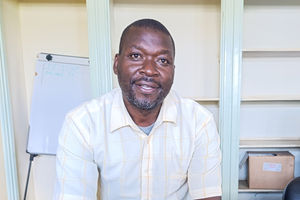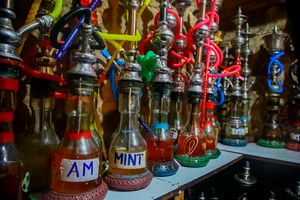
Two men smoking marijuana.
An increasing number of young people in Kenya are choosing hard drugs over alcohol and cigarettes, posing a growing concern for families and health authorities.
The National Authority for the Campaign Against Alcohol and Drug Abuse (Nacada)’s recent study reveals that 18.6 percent of university students are using drugs, with 8.5 percent in need of rehabilitation.
A spot-check of many rehabilitation centres in cities shows an alarming high number of young Kenyans and older ones who started doing drugs in their youth and are struggling to stop.
While alcohol remains the most accessible substance in universities, drugs like marijuana, cocaine, and ecstasy are gaining popularity, which users say give them longer highs, do not have an odour to raise suspicion, and are perceived lower risks.
Nacada attributes this shift to peer pressure, academic and family stress, lack of mentorship, and even exposure to trauma.
Dr Anthony Omerikwa, Nacada’s CEO, warns that the rise in drug use among students reflects deeper societal issues—unemployment, mental health struggles, and the breakdown of community support systems.
“This is not just a university problem. It’s a national crisis,” he said.
Coping with pressure
Ian, a university graduate, exemplifies the struggle. He chooses to use his first name as he meets with Nation Lifestyle outside Nairobi’s National Archives.
His laid-back attire hides the weight of expectation he carries as the eldest child in a family that had high hopes for his future. He says his family does not know he uses drugs.
“Life is hard, very hard,” he says. “Getting a job is a lot of stress, and my family expects a lot.”
He says he uses marijuana and khat, claiming that alcohol has severe physical effects. Drugs, he says, help him escape the realities of unemployment and manage anxiety and depression without the hangovers and emotional instability alcohol brings.
I ask him if he knows the long-term impact on his health.
“I avoid alcohol and pills because they have severe effects on the body—liver cirrhosis, kidney failure... Weed doesn’t do that,” he insists.
Doctors say marijuana and khat have adverse side effects too. They cause manic behaviour, paranoia, psychosis, mood changes, aggressiveness, and high blood pressure.
They also worsen anxiety and depression, conditions that some of these young people are using hard drugs to escape.

The rule will also reduce the risk of lung cancer and other tobacco-related diseases as well as the burden of disability and severe illness.
Music scene and drug culture
Joseph, a 33-year-old musician, says his years in the US and within Kenya’s creative scene led him to believe drugs were essential to artistic expression.
Over the years, he has used marijuana, ecstasy, and cocaine, often simultaneously. He says he used them in the perceived pursuit of heightened creativity.
“At first, it was just weed and cigarettes, but eventually, I was using four or five substances at once,” he says. “It stopped being about making music. It became about survival, an addiction, somewhat.”
Now sober for three years, Joseph reflects on the damage: financial loss, emotional instability, and the end of meaningful relationships.
He is currently writing a book, Breaking Free: How to Beat Any Addiction on Earth, to share his journey and inspire others to stop taking drugs.
Inherited habits and accessibility
For Njuguna, drugs have become a habit now. He fears that he might be just like his father but it has become a hard habit to drop.
His father, an addict, died when Njuguna was five. The 23-year-old began using marijuana and alcohol in high school, eventually abandoning alcohol due to blackouts and memory loss.
“I use weed daily. I started as a habit to calm me without messing with my head like alcohol does,” he says.
To mask the smell from his family, he says he adds homemade spices.
Party drugs and escapism
Jane, a soft-spoken young woman with a carefree smile, speaks of drugs like cocaine and crystal meth with a strange mix of detachment and familiarity.
“It started at parties. I wanted to fit in; little did I know I would be addicted,” she recalls.
Now, she says she uses the drugs to escape the pressure of being the eldest child in a jobless household.
“They put me in my own world... I’m always smiling,” she says.
Bar owners say they have also noted more young people using hard drugs in addition to alcohol. The youth, the bar owners who spoke to Nation Lifestyle say, come in already high, with no alcohol smell.
They just go to bars just to blend in, often choosing mocktails over alcohol while using drugs in private. Shisha, although banned in Kenya since 2017, has also grown in popularity because it is laced with hard drugs. Nacada, in a past report, said 79.4 percent of shisha samples collected in Nairobi and Mombasa tested positive for heroin.
“Adulteration of shisha with heroin may be an endemic problem in the country now, and there is a likelihood that shisha may be emerging as a concealment route for heroin trafficking,” the report read.
According to Nacada, cannabis remains the most abused narcotic, followed by tobacco, shisha, and synthetic products like vapes and nicotine pouches. University students mostly access drugs through friends, nearby bars, online platforms, and, alarmingly, even university staff and lecturers.
“We need urgent, collective efforts focused on prevention, treatment, and long-term support,” Dr Omerikwa said.








